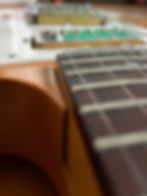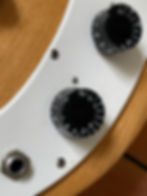1975 Gibson Marauder, as made famous by Thurston Moore
It's not just Jazzmasters and Jaguars for Thurston Moore. But it's always going to be something edgy. And Gibson's Marauder with its Flying V headstock, plate-mounted controls, and humbucker/single coil combination ticks all the boxes. Check out the phenomenal change in tone between those pick-ups!
"Marauder (n): a person or animal that goes from one place to another looking for people to kill or things to steal or destroy." Makes you wonder what type of player Gibson were targeting in the mid-Seventies. They certainly marketed it as a big rock guitar - "an evil power machine". Kiss' Paul Stanley stood front and centre of their advertising. Not sure how long that relationship lasted, given Paul's penchant for using a Marauder as the guitar to smash up at the end of each show. I suppose any publicity is better than no publicity. But it was really the edgier players that made it their own: Thurston Moore, his bandmate Lee Ranaldo, Johnny Ramone, Pete Shelley, Josh Homme. Guitarists playing at the edge, playing thick, and fast.
Marketing aside, the choice of name may have been triggered by a fight response to the Japanese brands that were eating the very lunch that the established US giants had enjoyed up until the 70s. There may have been lawsuits, and Gibson may have won the odd pitched battle, but the truth is that the Japanese guitar makers were coming up with models that were winning the war - on quality, and definitely on price. You get what you give - it was Gibson that sowed the seeds for this Japanese invasion with the move of all Epiphone production to Japan in 1970.
Enter the Marauder, one of Gibson's early responses to the competition. A budget model, with lower production costs, but still proudly a USA Gibson. The Flying V headstock and bolt-on neck may have you thinking this was just a rehash of other parts. But it's a lot more than that. The originals come with two Bill Lawrence designed pick-ups, specially crafted for the Marauder - a potted Super Humbucker at the neck and a potted Single-Coil at the bridge. A previous owner has taken that one stage further and replaced the neck humbucker with a 70s T-Top. Honestly, I've never yet heard such a dramatic difference in tone between a neck and bridge pick-up. All the warmth of a classic Gibson humbucker to the cut and twang of, yes, a Telecaster. The Gibson and Fender camps can put down their placards for a short armistice. This guitar meets them in no-mans-land.
To Sonic Youth fans, it's known as the "Expressway" guitar, the one Thurston played on 1986's Expressway To Yr. Skull. If you're new to Sonic Youth in their early ground-breaking years, this is the song for you. With a hypnotic drone outro that must have been the inspiration for many a shoegaze band to follow. The story goes that Thurston got the guitar from bandmate Lee Ranaldo, used it for the recording, a few live shows, and then it was stolen in December 1986. Only to turn up again, stripped down and beaten up, in 2006. For most of us, that would be a big deal. But knowing Sonic Youth - and the lab experiments and tortures they put their guitars through - it may have looked exactly the same if they'd had the guitar for that 20 years ;-). Not so this one. In great condition, and plays beautifully. Has to be heard to be believed!
See & Hear It In Action
-
Gibson Marauder Promotion Record (1974): Long before YouTube demos, there was vinyl. And Gibson made a virtue of this in the mid-70s with demo 45 singles for guitars like the Ripper Bass and Marauder. The Country Style and Mellow Jazz clips give you the full range of tones. But check out Side 2 for a slice of classic 70s funk!
-
Expressway To Yr. Skull (1986): Setting the bar for every shoegaze band to follow, with Thurston-penned Expressway, or, as also known, Madonna, Sean and Me. Played on a Gibson Marauder - it isn't all Jazzmasters and Jaguars.

Feedback
Specification
Make
Gibson
Model
Marauder
Colour
Natural Satin
Year
1975
Serial Number
551441
Number of Frets
22
Fretboard
Rosewood, Unbound
Neck
Maple
Body
3-piece Alder
Tuners
6 x Kluson double-line, double-ring "GIBSON DELUXE"
Pick-ups
Gibson "T-Top" Humbucker, PAT. NO. 2,737,842; Gibson Marauder single-coil blade
Bridge
Gibson "Harmonica" Tune-O-Matic
Tailpiece
Gibson Stop Bar
Scale Length
24.75"
Full Length
39.2"
Further Information:
-
The first Marauder was launched in 1974 as a budget model. Well, budget model for a Gibson. It would still have cost you around $350 to buy one in 1975. That's just short of $2000 in today's money. But production costs were cut to create something different - and innovative - versus the typical Gibson design: the bolt-on neck, scratchplate-mounted electrics and alder body in place of mahogany, in particular. It could almost be a Fender . . .
-
And that carries through into the slanted bridge pick-up. A Bill Lawrence designed single coil potted pick-up that gives you all the twang of a Tele. This one has the clear casing that you got with the earlier Marauders, giving rare visibility to the former bars, coil and magnet.
-
The original neck pick-up was a modified Super Humbucker, also in a clear case - designed to be as warm a contrast to the bridge pick-up as you could imagine. At some early stage, a previous owner thought this wasn't warm enough, and replaced it with a gold-plated "PAT. NO. 2, 273, 842"-stamped T-Top. T-Tops were first stamped with the PAT. NO. in 1974. So, this would be a pretty contemporaneous pick-up mod - though it looks like the gold-plated original had seen some pretty heavy action before, or since, its installation.
-
More intriguing is the Volume pot. It's a CBA pot from May 1966. The CBA pot was the common choice for Gibson scratchplate-mounted builds. But it's weird to see a pot that predates this guitar by nearly 10 years. It's just a guess, but I'm thinking the original needed replacement at some stage, and this was the first pot that came to hand. Nothing more mysterious than that.
-
The pick-up and pot choices are geeky incidentals. What's amazing about this guitar is the tonal versatility you get from the humbucker/single-coil pairing. The warmth of a cooking Les Paul to the clean twang of a Tele - in one guitar. Budget guitar this may be, but it's a great example of necessity as the mother of invention. Once the cash-strapped 70s were passed, and Gibson got into their reissues, the burning platform for competitive innovation kind of fizzled out. The 70s were not all doom and gloom though - and this guitar is a fabulous reminder of the light that can come out of hard times!
Sources & Links
-
The Gibson Marauder on Vintage Guitar And Bass: If ever you want to find out more about the history of an iconic guitar, Vintage Guitar And Bass is the place. Everything you need to know about the history, spec, shipping numbers, components and marketing. Absolutely invaluable!
-
Gibson Marauder Bridge Pick-up: Again, thanks to Vintage Guitar And Bass, dig around there's loads to read about the Marauder's two pick-ups, the harmonica bridge, and even that mysterious 60s CBA pot . But that bridge pick-up is the most unique, so here's the detail, plus some great shots of the inner workings..
-
The Sonic Youth Gear Page: Stand in awe of the research Chris Lawrence has put into cataloguing the guitars and gear used by Sonic Youth over the years. Just incredible!
















